Affectionate, gentle and even-tempered!
Advertisement
Bloodhound Scientific Classification
- Kingdom
- Animalia
- Phylum
- Chordata
- Class
- Mammalia
- Order
- Carnivora
- Family
- Canidae
- Genus
- Canis
- Scientific Name
- Canis lupus
Read our Complete Guide to Classification of Animals.
Bloodhound Conservation Status
Bloodhound Facts
- Temperament
- Kind, patient and noble
- Training
- Should be trained from an early age due to their large size
- Diet
- Omnivore
- Average Litter Size
- 7
Bloodhound as a Pet:
- General Health
- Energy Level
- Shedability
- Trainability
- Intelligence
- Tendency to Chew
- Size
- Family and kid friendliness
- Yappiness / Barking
- Moderate
- Separation Anxiety
- Moderate
- Preferred Temperature
- Average climate
- Exercise Needs
- High
- Friendly With Other Dogs
- Moderate
- Pure bred cost to own
- $700
- Dog group
- Hound
- Male weight
- 90-110 lbs
- Female weight
- 79-99 lbs
This post may contain affiliate links to our partners like Chewy, Amazon, and others. Purchasing through these helps us further the A-Z Animals mission to educate about the world's species.
View all of the Bloodhound images!
Bloodhounds are large dogs that were originally bred in medieval France for hunting deer and wild boar. Later, they were also used for tracking down people.
Bloodhound dogs are very intelligent and have an extremely good sense of smell which has also helped them earn a high reputation in the search and rescue department and the law and enforcement arena. They are also known to be highly active and have a unique appearance. Other than that, they are also kind and affectionate. These dogs are usually purebred and can often be found in adoption shelters and rescue groups.
See all of our expert product reviews.
Initially, there was confusion over whether bloodhounds and sleuth hounds were the same. However, while bloodhounds are known to be swift, sleuth hounds are known to be slow and lazy. Sleuth hounds were known to be the Scottish counterparts of bloodhounds.
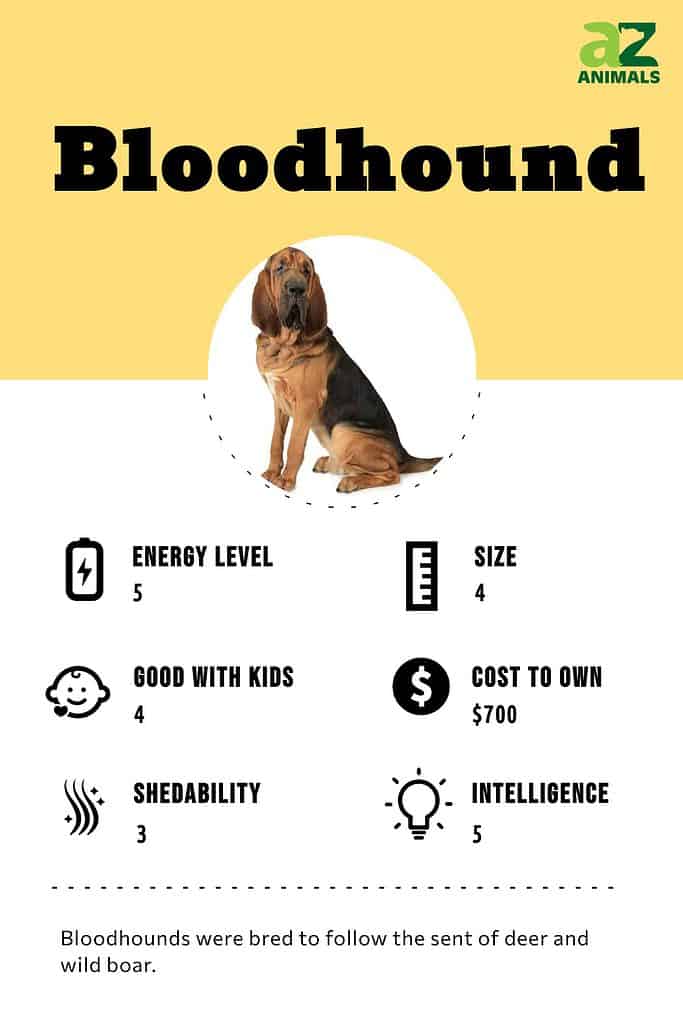
Three Pros and Cons of Owning a Bloodhound
For anyone that is considering adopting this breed, you should know that these animals come with a range of pros and cons — much like any other animal. Some of them are:
| Pros! | Cons! |
| Affectionate in nature Bloodhounds are known to have an affectionate and gentle nature which makes them even more desirable to people. They are very loving and friendly towards their owners. | Clumsy These dogs are very clumsy, and owning them could cause problems as they can create chaos around the house. |
| Tracker dogs Bloodhounds are best known as tracker dogs and were used in earlier times to track down people and hunt deer and wild boars. They have a heightened sense of smell. | Not fit for young children and older adults These dogs are usually only suitable for physically fit people who can handle large-size dogs and the energy that usually comes with them. They are known to knock down very small children, accidentally, of course. |
| Tracking companion They are an amazing tracking companion. Hunters, fishermen, and other outdoorsy families would be an ideal match for a bloodhound. | Stubborn This breed is stubborn, and it can sometimes be difficult for the owners to maintain control over them. |
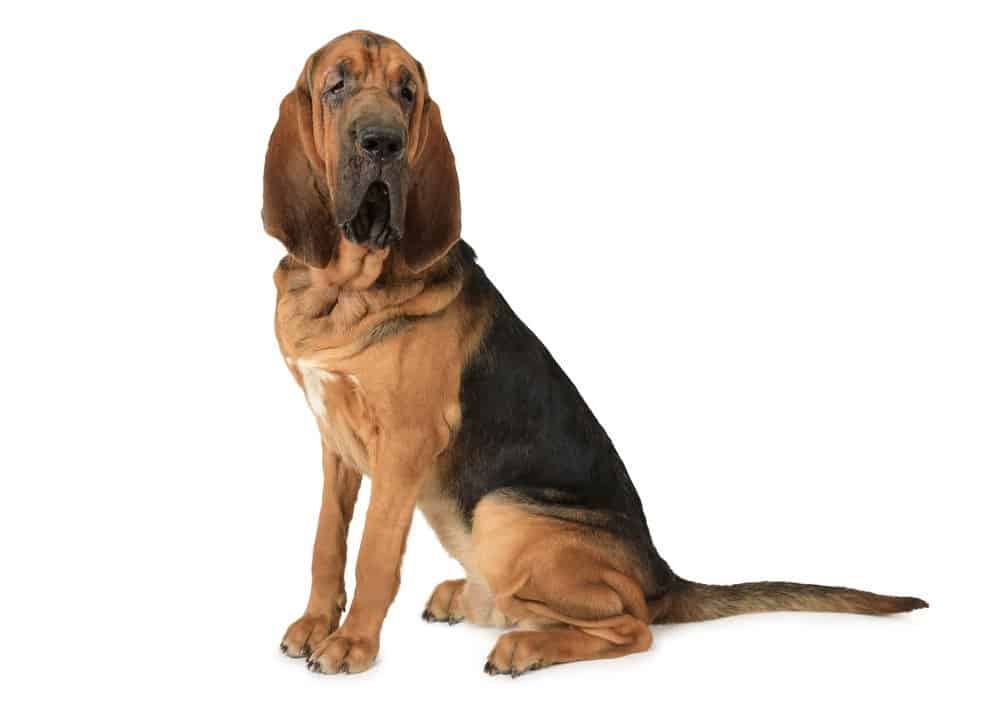
©Kuznetsov Alexey/Shutterstock.com
History and Origins
It is uncertain when the bloodhound breed originated, but some experts believe they were present in the ancient Mediterranean. Aelian, a third-century scholar, wrote in his “Historia Animalium” of a hound with an impressive sense of smell, so focused on its task that it could not be pulled away from the trail until the target was found. The bloodhound is thought to be the oldest hound still around that utilizes scent to hunt and is seen as a predecessor to breeds like the black and tan coonhound and related coonhound varieties.
Around one thousand years ago, bloodhounds were developed in Western Europe, and the credit for their careful breeding is given to high-ranking members of the pre-Reformation church. During medieval times many influential members of the church kept packs of hounds on the grounds of monasteries in England and France. The monks in charge of the breeding program were so diligent that their hounds were referred to as “blooded hounds,” indicating that they were of noble descent.
Health and Entertainment for your Bloodhound
See all of our expert product reviews.
Throughout the years, bloodhounds have earned a good name for their unmatched capability of tracking humans. Law enforcement agencies have been relying on these strong-willed dogs to follow scents that could lead to a criminal, a missing child, or a lost hiker. The assignment could go on for days, regardless of the terrain, and bloodhounds will never give up until the trail is finished. Despite the development of advanced scenting technology, nothing has been able to match the accuracy of the bloodhound nose.
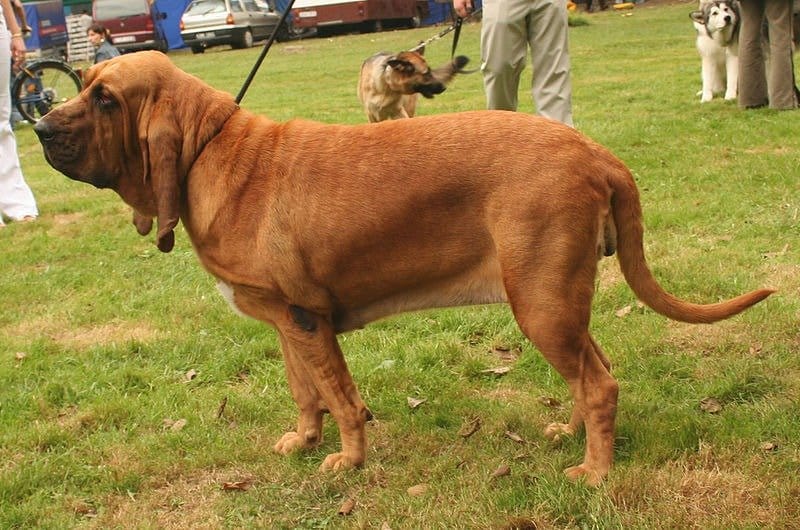
Bloodhounds will never give up on a scent.
©Pleple2000, CC BY-SA 3.0, via Wikimedia Commons – License
Size and Weight
Bloodhounds are large and sturdy dogs and were originally bred for hunting deer and wild boar. They can also very keenly sense smells and are often used to track people.
The female of the species is usually 23 to 25 inches in height, while the males are 25 to 27 inches. Females weigh about 36 to 45 kgs, while males weigh 41 to 50 kgs.
| Height | Weight | |
| Male | 25 to 27 inches tall | 90 to 110 lbs., fully grown |
| Female | 23 to 25 inches tall | 79 to 99 lbs., fully grown |

Bloodhounds weigh between 79-110 pounds.
©Bruce, CC BY 2.0, via Wikimedia Commons – License
Common Health Issues
Bloodhounds are generally known to be a very healthy breed of dog. They usually have a lifespan of around 10 to 12 years. However, like any other living creature, they are not completely safe from diseases.
These dogs can suffer from hip dysplasia, which is an abnormal formation of the hip muscles, or elbow dysplasia, which is the abnormal formation of the elbow bones. They are also susceptible to bloating, which might lead to stomach-related conditions and could be due to indigestion or other underlying conditions.
Other than that, there are other problems like heart conditions and eye conditions like patellar luxation, cataracts, and persistent pupillary membranes that the bloodhounds suffer from.
The common health problems that bloodhounds suffer from include the following:
- Hip dysplasia
- Elbow dysplasia
- Bloating
- Heart conditions
- Eye conditions
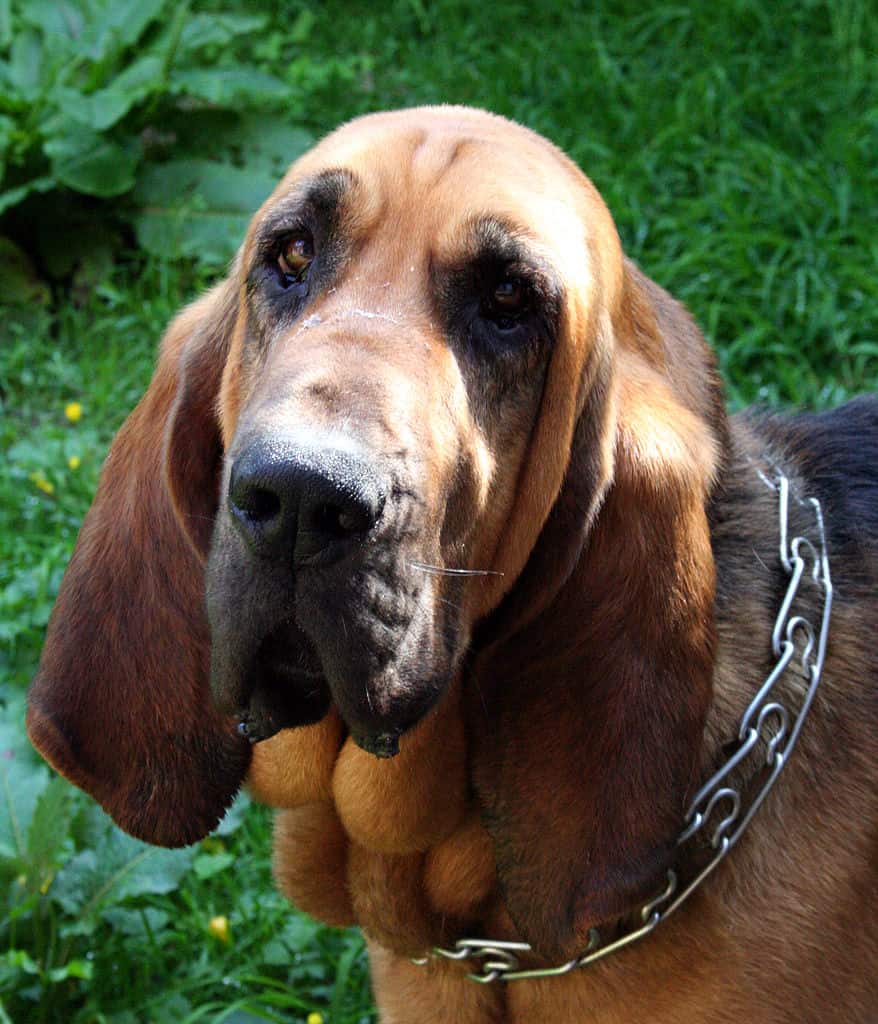
Bloodhounds are prone to dysplasia of the hips and elbows.
©Pypaertv, CC BY-SA 3.0, via Wikimedia Commons – License
Temperament
Bloodhounds are gentle and patient and are known to be noble dogs. These dogs are also known to be especially great with children and are also patient enough to let young children get all over them. They don’t seem to realize that they are gigantic dogs and have been known to accidentally knock small children over, so supervision is recommended.
Even though the bloodhounds are very well-mannered, they are independent and very determined. These dogs are also known to make individual decisions – free of anybody else – which usually happens when they sense a particular scent. They must follow their nose!
They are also known to make melodious music noises like howling and whining noises and are known to be one of the most melodious dog breeds. If you don’t like a talkative dog, a bloodhound is not for you.

Bloodhounds are well-mannered dogs that are good around children.
©Pleple2000 / Creative Commons – License
How to Take Care of a Bloodhound
To be able to own a pet, it is important to know how to take care of them. Here are a few things you should take care of Bloodhounds.
The Best Dog Food
Adult bloodhounds usually need about 18 percent protein and five percent fat. The common foods that you can feed to your bloodhound include chicken, salmon, vegetables, fish, and brown rice.
However, bloodhound puppies should usually be fed dry dog food, chicken, sweet potato, and other large-breed puppy foods, which ultimately help in their overall growth and development.
Since this breed can struggle with heart conditions, steer clear of the legumes like peas in many dog foods that have been linked to heart failure.
To address their dietary needs, A-Z Animals believes the best dog food for Bloodhounds is Wellness CORE Digestive Health Dry Dog Food with Wholesome Grains, Real Meat & Brown Rice, Sensitive Stomach Dog Food, Easily Digestible, Natural.
This formula is designed for smooth digestion, so the kibble is coated in probiotics for the microbiomes of dogs like Bloodhounds prone to bloat. On top of digestive enzymes, real fish is a natural source of omega 3s which behave like antioxidants. Taurine has the dual benefits of aiding in both heart and eye health.
Check Chewy and Amazon for this product.
Maintenance and Grooming
Bloodhounds usually do not require much maintenance and grooming except for regular cleaning of their ears and coat. They need to be bathed only three to four times a year. However, whenever that is done, it is always advisable that the bathing is done outside as there is a chance that they can slip and hurt themselves indoors.
Their ears need regular grooming. It is best to clean your bloodhound’s ears once a week as they can become a breeding ground for bacteria and other infections. Other than that, you should also brush your bloodhound’s fur once a week to remove the dead hair.
Training
Even though bloodhounds are known to be tracker dogs and engage in a lot of physical exercises, they will often test you while training.
They are intelligent and stubborn and can outlast even the most patient trainer. It requires time and patience, and lots of snacks to reach your training goals.
However, once they start following their owner’s lead, they just need gentle reminding until the behaviors become commonplace.
Exercise
Bloodhounds require a good amount of exercise. These dogs need about two hours of physical activity every day to keep them fit and satisfied. However, sometimes this alone cannot be enough.
For the sake of the bloodhound’s mental peace, they require to be taken outside for walks which helps them keep destructive and aggressive behaviors at bay.
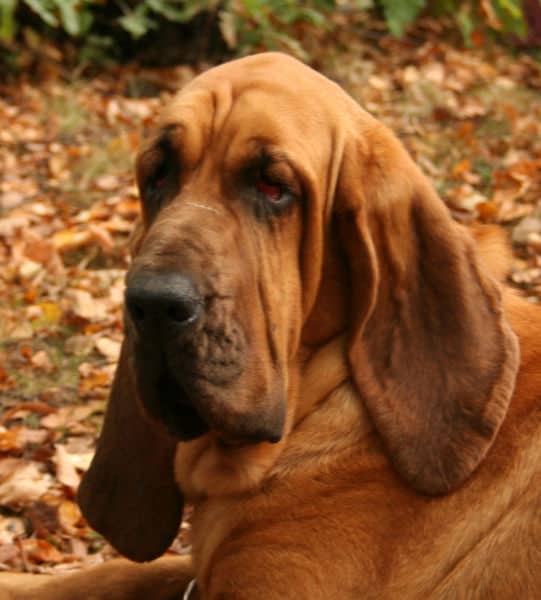
Bloodhounds require 2 hours of physical activity per day.
©Pleple2000, CC BY-SA 3.0, via Wikimedia Commons – License
Puppies
Bloodhound puppies need extra care since they are fragile and delicate during their initial days or months. However, as they grow up, a more relaxed care routine can be put in place.
Bloodhound puppies usually need to be fed chicken, sweet potatoes, and other large-breed puppy food that helps in their growth and development.
It is recommended to start training and grooming early in life to give your puppy time to become accustomed to those routines.

Start training your bloodhound puppy early.
©Ermolaev Alexander/Shutterstock.com
With Children
Bloodhounds are known to be very affectionate and loving and are especially great with children. They are also very patient and often allow young children to climb and get all over them.
Dogs Similar to Bloodhounds
Several dogs are like Bloodhounds. Some of them are:
1. Greyhound: While the Greyhound has a much slimmer body, they both can reach an average of two feet tall. Both are excellent companions for children and families, and they are even friendly strangers.
2. Beagle: Beagles have about the same lifespan as a beagle, and both are gentle enough to be around children. While the bloodhound requires a little more attention and care during grooming, the beagle is much easier to groom. Both are incredibly vocal, acting as an alarm system with their bark to protect the home.
3. American Foxhound: These dogs are used for hunting foxes based on their scent, using their skills of heightened smelling sense to get the job done – much like bloodhounds.
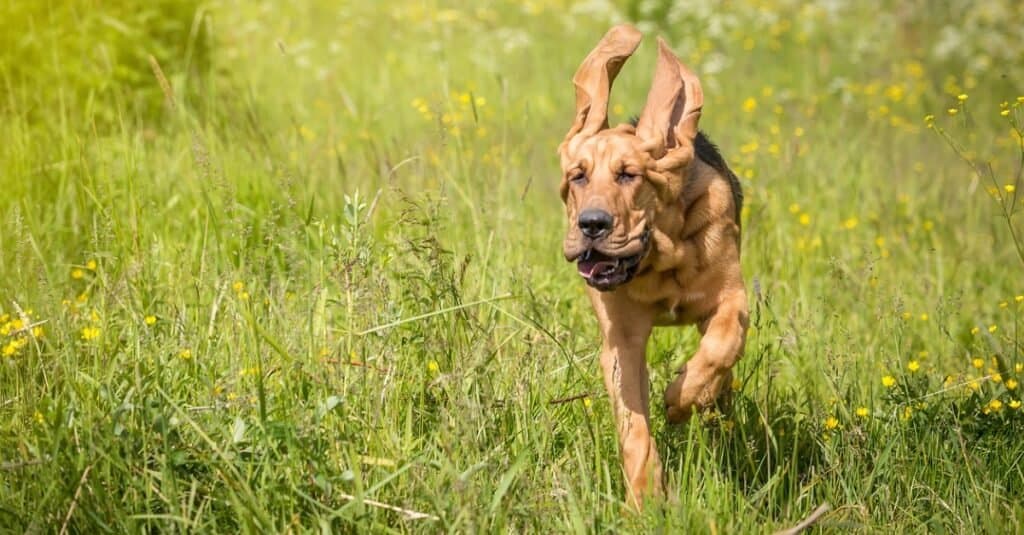
The bloodhound was originally bred to follow the scent of deer and wild boar.
©iStock.com/Edoma
Famous Bloodhounds
There are many famous bloodhound dogs. Disney has integrated the floppy-eared dog as some of their most popular characters, like Pluto, Trusty (from Lady and the Tramp), Bruno (from Cinderella), and Copper (from The Fox and the Hound). Disney even has used the bloodhound as the character Bumpus Hounds in their holiday film The Christmas Story.
On television, the bloodhound found its way onto the set of “The Beverly Hillbillies.” Duke, the dog of the character Jed Clampett, was played by a bloodhound named Stretch.
Thanks to the bloodhound’s ability to track scents, the bloodhound’s most important role has been that of a police dog, which they are commonly used in France. Nick Carter, owned and handled by Captain G. V. Mullikin, is commonly considered to be the epitome of trailing for these dogs, and he is credited with 650 finds. One of these discoveries occurred after following a 12-day-old trail.
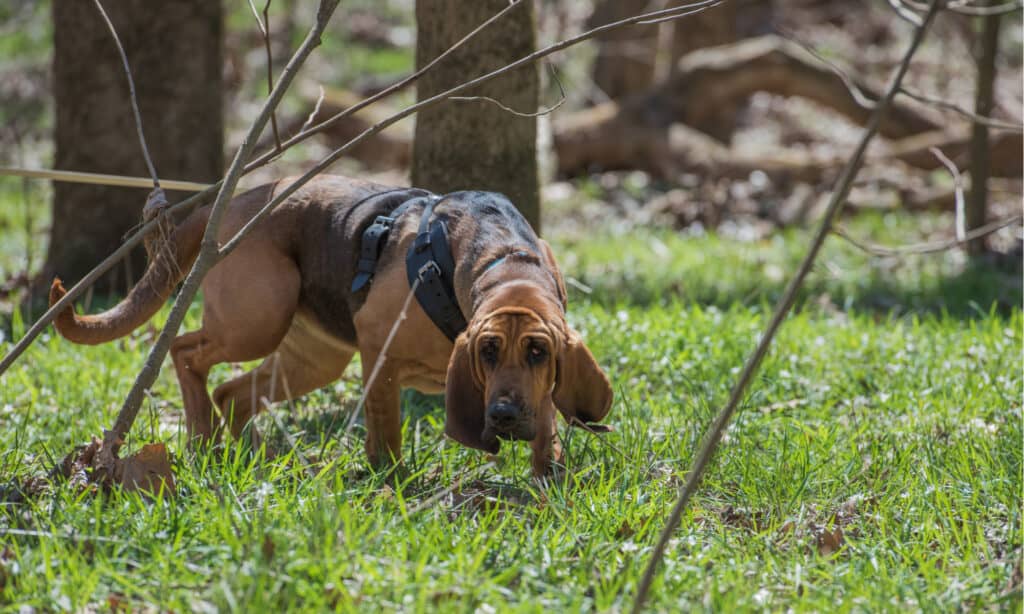
Bloodhound tracking is used today by many police and rescue groups.
©NSC Photography/Shutterstock.com
Popular Names
Here are some of the common names for bloodhounds:
- Magnum
- Sumo
- Tex
- Burly
- Thunder
Bloodhound FAQs (Frequently Asked Questions)
How much does a bloodhound cost to own?
Buying a bloodhound could cost you about $700. However, the maintenance could cost you anywhere between $1,400 to $5,500 per year.
Is the bloodhound good with kids?
Bloodhounds are great with kids and often show a lot of patience with the younger children. These dogs are known to be loving and affectionate.
How long does a bloodhound live?
Bloodhounds live 10 to 12 years on average.
Do bloodhounds make good house pets?
Yes, bloodhounds are known to make great family pets and are very loving and affectionate towards their owners.
Are bloodhounds aggressive?
No, bloodhounds are not usually aggressive.
Are bloodhounds smart?
Yes, bloodhounds are known to be a breed of intelligent, alert, and determined dogs.
Are Bloodhounds herbivores, carnivores, or omnivores?
Bloodhounds are Omnivores, meaning they eat both plants and other animals.
What Kingdom do Bloodhounds belong to?
Bloodhounds belong to the Kingdom Animalia.
What class do Bloodhounds belong to?
Bloodhounds belong to the class Mammalia.
What phylum to Bloodhounds belong to?
Bloodhounds belong to the phylum Chordata.
What family do Bloodhounds belong to?
Bloodhounds belong to the family Canidae.
What order do Bloodhounds belong to?
Bloodhounds belong to the order Carnivora.
What genus do Bloodhounds belong to?
Bloodhounds belong to the genus Canis.
What type of covering do Bloodhounds have?
Bloodhounds are covered in Hair.
How many babies do Bloodhounds have?
The average number of babies a Bloodhound has is 7.
What is an interesting fact about Bloodhounds?
Bloodhounds are affectionate, gentle, and even-tempered!
What is the scientific name for the Bloodhound?
The scientific name for the Bloodhound is Canis lupus.
What are the differences between Bloodhounds and Coonhounds?
The main differences between bloodhounds and coonhounds are size, color, build, and their main uses. Bloodhounds are much heavier than coonhounds and have a heavier build. They also have wrinkled skin on their neck while coonhounds don’t. However, coonhounds have a much wider variety of colors than bloodhounds which are limited to three colors.
What's the difference between a Bloodhound and a Basset Hound?
The Bloodhound is much larger than the Basset Hound, though they both live a similar lifespan. Additionally, the Basset Hound is less wrinkled compared to the average Bloodhound.
Thank you for reading! Have some feedback for us? Contact the AZ Animals editorial team.
Sources
- Dogtime.com, Available here: https://dogtime.com/dog-breeds/bloodhound#/slide/1
- Wikipedia, Available here: https://en.wikipedia.org/wiki/Bloodhound
- Wikipedia, Available here: https://en.wikipedia.org/wiki/Sleuth_hound
- DogBreeds911.com, Available here: https://www.dogbreeds911.com/large-dog-breeds-bloodhound.html
- Embrace Pet Insurance, Available here: https://www.embracepetinsurance.com/dog-breeds/bloodhound
- Hill's, Available here: https://www.hillspet.com/dog-care/dog-breeds/bloodhound
- Purina, Available here: https://www.purina.com/dogs/dog-breeds/bloodhound
- Bloodhound Information UK, Available here: http://www.bloodhoundinformationuk.co.uk/bloodhound-maintenance
- The Nest, Available here: https://pets.thenest.com/care-bloodhounds-5586.html
- Bloodhound Man Trackers, Available here: https://www.bloodhoundmantrackers.org/bloodhound-training.html
- Borrow My Doggy, Available here: https://www.borrowmydoggy.com/doggypedia/guide-to-dog-breeds/bloodhound-information-guide
- Care.com, Available here: https://www.care.com/family-pet-guide-dogs-hounds-bloodhound-p1104-q168381.html
- The Paws, Available here: https://www.thepaws.net/90-best-bloodhound-dog-names/


















